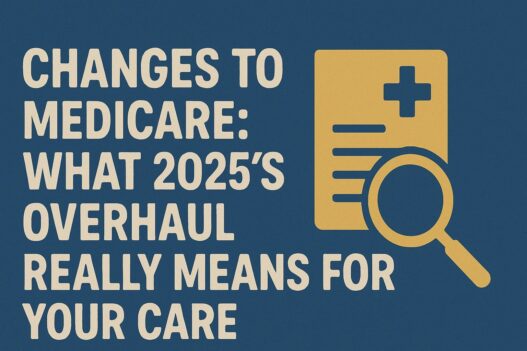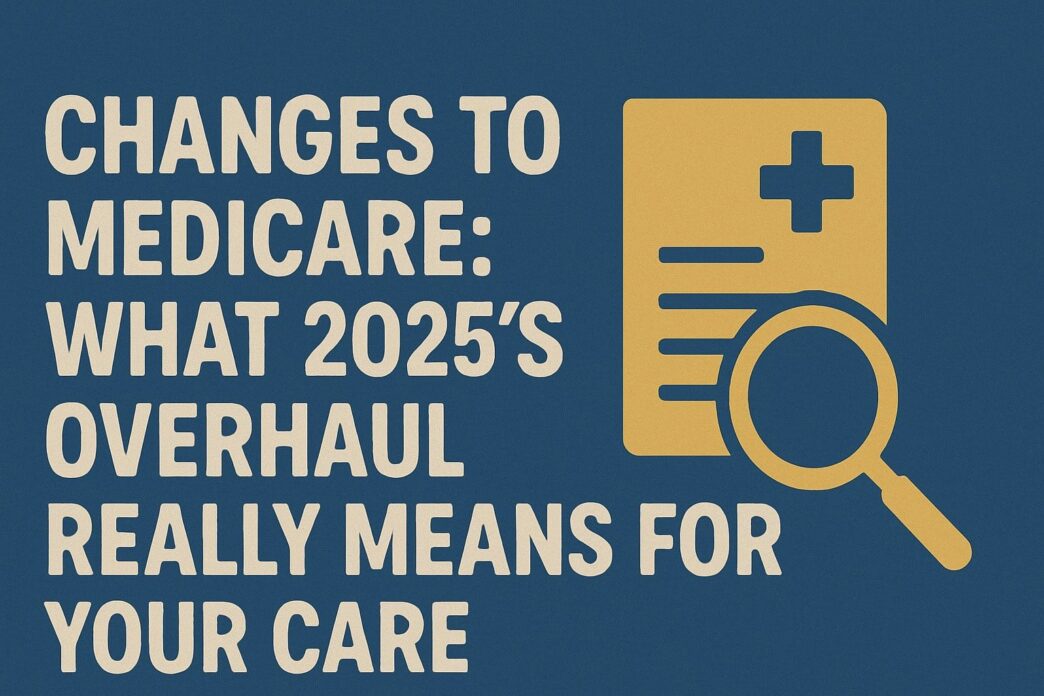“Through the historic Inflation Reduction Act, the Medicare program is meeting the needs of people with Medicare more than ever before,” said CMS Administrator Chiquita Brooks-LaSure, earlier this fall. The CMS assures us all that Medicare will “remain stable.” But for the 69 million Americans who depend on the program, the recent “subtle” have created confusion at an already strained state of affairs.
The Medicare changes taking effect in 2025 will alter how Medicare coverage is verified, how healthcare insurers get paid, and how physicians document care.
Traditional Medicare is tightening its administrative checks, while Medicare Advantage (once Washington's favorite efficiency model) faces unprecedented scrutiny over inflated risk scores and denied claims. On paper, these are accountability measures; in practice, they will shake up the entire healthcare economy from the bottom up.
Regulators at CMS have taken steps to rein in “overpayments” to Medicare Advantage plans, a step that has provoked pushback from the private insurers who built their business models around predictable margins and generous supplemental benefits.
The end result is a healthcare system being squeezed from both directions, with less public coverage at one end and a more constrained private plan market at the other.
At a time when Medicare accounts for roughly one in five dollars (21% of total NHE or roughly $1.03 trillion) spent on health care nationally, will these “efficiency” reforms continue to preserve the promise of care?
Let's look at the changes, the likely market responses, and what beneficiaries and clinicians should do during the most consequential Annual Enrollment Period in years.
Also read: Medicare Physician Payment Cuts 2025: 2.8% Reduction Impact and What Doctors Need to Know
1. Part D
The new Part D catastrophic cap is the change most beneficiaries have heard about. $2,000 out-of-pocket in 2025, rising to $2,100 in 2026 (inflation-indexed thereafter).
That cap will prevent a handful of patients on very expensive therapies from facing ruinous drug bills.
But the cap is, by no means, a universal antidote. KFF analysis suggests only a small share of beneficiaries actually reach the cap in a given year, so the policy protects a minority directly while altering incentives for plans and manufacturers.
Insurers can now collect at most the deductible plus the capped out-of-pocket amount from enrollees, while the plan or the system must absorb the rest.
Carriers will respond by protecting margins, and that usually entails narrowing formularies, shifting drugs to higher tiers, reducing low-premium stand-alone Part D offerings, and increasing utilization controls.
Insurers have discontinued inexpensive plans in prior years and passively shifted members into pricier default products if they didn't actively re-shop during open enrollment. Expect similar behavior in 2025–2026.
CMS has set the maximum allowable Part D deductible at $615 for 2026 (an increase from $590 in 2025). Individual plans can set lower deductibles, but none can exceed that cap. If your plan has a deductible, you pay full gross covered drug costs until it's met.
After that, many plans move to 25% coinsurance for most drugs until you hit the out-of-pocket threshold. Carriers can tweak deductibles and tiering as another way to manage exposure after the catastrophic cap.
Beneficiaries would do well to never judge a plan by its headline premium alone. Model your likely annual drug cost under each candidate plan (premiums + deductible + copays/coinsurance + catastrophic cap).
If you take specialty drugs or have changing regimens, run a worst-case scenario before making your choice.
2. Medicare Prescription Payment Plan (MPPP)
MPPP, introduced in 2025, lets beneficiaries amortize annual prescription costs over the calendar year instead of paying the full fill price at the pharmacy counter.
Beginning in 2026, MPPP participation will auto-renew each year unless the enrollee opts out. Plans must process opt-out requests within three calendar days.
Auto-renewal aims to reduce friction for people who benefit from smoothing, but it also creates passive defaults insurers can exploit if plan terms or price structures change.
3. SSBCI Limits
CMS tightened what counts as a Special Supplemental Benefit for the Chronically Ill (SSBCI) in Medicare Advantage (MA).
The agency codified a non-exhaustive list of non-health-related items that cannot qualify. Examples include: life insurance, funeral planning, alcohol, cannabis products, broad membership programs, and non-healthy food.
Those protections narrow the creative uses of rebate dollars that many MA plans used to attract enrollees. Now, those MA plans will have to reallocate rebate dollars or trim previously generous supplemental services.
4. Insulin Protections
Insulin cost-sharing protections that limited monthly out-of-pocket insulin costs to around $35 are now annualized in the program starting in 2026.
Plans must ensure insulin cost-sharing equals the lesser of $35, 25% of the maximum fair price under negotiation, or 25% of the negotiated plan price.
That's a clear win for diabetics on Medicare as it reduces adherence-sapping costs and improves predictability.
5. ACIP Adult Vaccines
Part D plans must continue to waive deductibles and cost-sharing for adult vaccines recommended by the Advisory Committee on Immunization Practices (ACIP).
This permanent benefit strengthens preventive care for older adults, but it's important to remember that the ACIP list can change year to year.
6. Prior Authorization In Original Medicare
Beginning January 1, 2026, CMS will pilot prior authorization in Original Medicare via models like WISeR (Wasteful and Inappropriate Service Reduction) in select states, namely, New Jersey, Ohio, Oklahoma, Texas, Arizona, and Washington.
CMS frames the pilot as AI-assisted streamlining, with licensed clinicians making final decisions, not machines.
“CMS is committed to crushing fraud, waste, and abuse, and the WISeR Model will help root out waste in Original Medicare,” said CMS Administrator Dr. Mehmet Oz.
“Combining the speed of technology and the experienced clinicians, this new model helps bring Medicare into the 21st century by testing a streamlined prior authorization process, while protecting Medicare beneficiaries from being given unnecessary and often costly procedures.”
Wasteful care drives up costs and endangers patients. Medicare's advisory commission estimates (PDF) that in 2022 alone, about $5.8 billion went to services with little or no clinical value.
Still, this is a major change as prior authorization, previously more common in MA, will enter the fee-for-service world. Resulting in…you guessed it, more documentation requests, possible delays for elective procedures, and extra administrative burden for clinicians.
Medicare Advantage
Since its inception, Medicare Advantage's growth has been dramatic. As of 2025, MA covers roughly 34.1 million beneficiaries, making up more than half of Medicare enrollees, and has reshaped how seniors access care.
But that growth has masked two problems:
- Evidence that MA plans have been paid more than equivalent costs in fee-for-service Medicare.
- And spotty consumer protections when plans narrow networks or change benefits.
MedPAC's March 2024 analysis (PDF) showed MA payments in 2024 were substantially higher.
MedPAC estimated that payments to MA plans were roughly 122% of what Medicare would have paid in fee-for-service, implying about $83 billion in extra payments in 2024 attributable to coding and selection differences.
CMS has moved to tighten risk-adjustment and increase audit enforcement to recoup inappropriate payments.
Those steps are the proximate cause of the industry noise, because when regulators try to align payments with true risk, insurers respond by cutting benefits, exiting markets, or narrowing formularies.
The insurer response is just predictable business logic. If the markets no longer support the prior benefit generosity, plans either reduce benefit richness, charge higher premiums, or simply withdraw low-margin products.
Several industry analyses and market trackers reported fewer MA and MAPD plans nationally in 2026, and dozens of counties saw plan exits.
Nationwide, the total number of non-SNP Medicare Advantage (MA-only) and Medicare Advantage Prescription Drug (MAPD) plans is projected to drop by 10%, from 3,719 in 2025 to 3,373 in 2026.
This will push beneficiaries to actively shop during AEP or be auto-assigned to carrier defaults.
MA plans often bundle attractive extras, such as dental, meals, transportation, and limited in-home services — all things that older adults value. When those perks vanish, the net value of MA versus Original Medicare changes.
And because MA networks commonly include under half the physicians available to traditional Medicare in many markets, network churn can force patients to change doctors or face higher out-of-network costs.
What This Means For Retirees And Clinicians
Policy changes usually mean more paperwork.
Whether it is responding to plan discontinuation notices, verifying eligibility for a benefit, or dealing with a prior authorization request for a service that used to flow without review, the system is asking beneficiaries to act more often and more precisely.
Miss a deadline, and coverage gaps appear.
If your MA plan withdraws from the county or trims its network, you'll have to shop for plans during AEP. That means contending with a bewildering set of tradeoffs between premiums, deductibles, formularies, and provider networks.
According to Fidelity, a 65-year-old retiring in 2024 faces roughly $172,000 in lifetime health expenses on average.
Medicare changes increase the volatility of that projection even if the average shifts modestly.
If carriers narrow formularies, raise deductibles, or withdraw low-cost options, retirees face higher tail risk in the form of sudden premium increases, new coinsurance obligations, or drug tiering changes.
From a financial planning standpoint, the smartest move is to assume volatility rather than stability. Here's how:
- Model your retirement health costs with a wider margin of error, and add roughly 10–20% to whatever you think you'll need for medical expenses.
- Keep a year's worth of health-related costs in liquid savings or short-term instruments to cushion against sudden premium hikes or deductible surprises.
- During AEP, run the numbers on both your current health regimen and a potential mid-year therapy change.
A plan that looks cheap up front can quickly become expensive once real-life medical needs set in.
Treat the Annual Enrollment Period (Oct. 15 – Dec. 7) as a time to get your financial ducks in a row.
- Build your medication ledger. List all drugs (name, dose, frequency), preferred pharmacies, and any manufacturer assistance you use.
- Compare total costs. For each candidate plan, calculate premiums + annual deductible + expected copays/coinsurance for your meds + worst-case specialty fills + catastrophic cap.
- Watch for plan discontinuation notices. Don't let a carrier auto-move you into a default plan. If your plan is discontinued, actively shop.
- Use SHIP. Your state's SHIP counselors are free and impartial. Book time early.
- Refill strategically. If appropriate and clinically safe, refill maintenance meds in late November/December to smooth gaps during a plan switch.
- Keep records. Save prior-authorization requests, appeals, and denial dates. You'll need them if disputes arise.
Clinicians, too, can expect to see some operational effects. More documentation pressure, stronger RADV audits and tighter risk adjustment mean coding accuracy matters.
Practices that undercode leave money on the table; those that overcode invite audit risk and clawbacks. MedPAC's assessments and CMS enforcement actions make this more salient.
With pilots expanding prior authorization into Original Medicare, practices will need robust PA workflows that handle both MA and Original Medicare requests. Turnaround times, appeals staffing, and tracking systems will be essential.
Practices can also expect to see more case-mix shifts and uncompensated care as MA exits and plan churn can push more complex, underinsured patients toward safety-net providers and EDs.
Hospital leaders should model revenue sensitivity to plan exits and potential increases in uncompensated care.
Financially, if hospitals push costs to commercial markets, employer premiums rise, eventually feeding into overall compensation negotiations and the personal financial calculus for high earners planning retirement. For physicians plotting an early exit or recalculating retirement timing, rising health-cost volatility should be baked into the forecast.
Learn more about Planning for Healthcare Costs in Retirement as a Physician
Where Are We Headed?
Two arenas will decide how this story unfolds. First, the political fight over whether Congress or states will blunt premium shocks. This case is most visible in the current standoff over ACA premium tax credits and state mitigation tactics.
Second, regulatory tussles over how far CMS will press audits, risk-score adjustments, and prior-authorization pilots.
Insurers will frame product exits as collateral damage of overbearing rules; advocates will frame them as the consequence of a market that previously relied on excess public subsidy.
If the program is to remain both efficient and humane, policymakers must pair accountability with practical protections.
What I want to know is, do these changes affect you, your patients, or your retirement plan? If so, what do you intend to do about it?
In case you missed it: What Physicians Need to Know About the Government Shutdown and Healthcare
Frequently Asked Questions
What is the new Part D out-of-pocket cap?
For 2025, the catastrophic cap is $2,000; it rises to $2,100 in 2026 (indexed thereafter). It limits catastrophic drug spending for those who hit the threshold, but only a minority of enrollees reach it each year.
Will my Part D deductible change?
The maximum allowable Part D deductible for 2026 is $615 (up from $590 in 2025). Plans can set lower deductibles but not higher.
If my plan disappears, will I be automatically moved into a more expensive plan?
Possibly. Carriers have previously auto-assigned members into a default product when a low-cost plan is discontinued. Don't assume the default is your best option. Actively shop during AEP if your plan is ending.
What is MPPP, and should I use it?
MPPP lets you spread prescription costs across the calendar year. As of 2026, participation auto-renews unless you opt out; opt-outs must be processed within three days. It smooths cash flow but creates passive defaults so read renewal notices closely.
Are insulin and vaccines still protected?
Yes. Insulin cost-sharing protections are annualized (plans must use the lesser of $35 or a 25% threshold). Part D must continue to waive cost-sharing for ACIP-recommended adult vaccines.
Will Original Medicare now require prior authorizations?
CMS will pilot prior authorization in Original Medicare starting Jan. 1, 2026, in six states under models like WISeR. Reviews will be tech-assisted, but clinicians make final decisions. Expect more documentation and potential delays for some services.
What are SSBCI limits, and do they affect my MA benefits?
CMS narrowed what counts as Special Supplemental Benefits for the Chronically Ill (SSBCI). Non-primary health items (life insurance, funeral planning, non-healthy food, etc.) are excluded. If you rely on an MA “perk,” check whether it survives your plan's 2025–26 design.
How steep is the MA market pullback?
Nationally, non-SNP MA-only and MAPD plans declined by about 10% (from 3,719 in 2025 to 3,373 in 2026), forcing many beneficiaries to re-shop or be auto-assigned.
Where can I get unbiased help during AEP?
Contact your state's SHIP (State Health Insurance Assistance Program) for free, unbiased counseling. Book early. AEP is Oct. 15–Dec. 7 and demand spikes.
What should retirees change in their financial plan?
Assume volatility. Add 10–20% contingency to projected healthcare costs, keep a 12-month health buffer in liquid savings, and model plan scenarios (stable meds and a potential mid-year specialty start) during AEP.


















